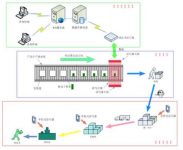
RFID edible oil anti-counterfeiting and anti-channeling management system solution
[ad_1]
1. Anti-counterfeiting significance
Generally speaking, anti-counterfeiting refers to the anti-counterfeiting of goods. Strictly speaking, it means that a genuine manufacturer or a professional anti-counterfeiting service agency entrusts a dedicated information, that is, information that cannot be obtained or copied by others, and cannot be imitated, as a mark. It is called anti-counterfeiting to note the information in the product and use the information as the authenticity identification measure of the product, and the technology applied to this is called the anti-counterfeiting technology.
2. Introduction of RFID technology
RFID (Radio Frequency Identification) is an emerging technology. It is composed of a reading and writing device and an electronic tag. The reading and writing device and the electronic tag automatically identify the target object through the radio frequency signal and obtain its related data.
RFID identification technology Radio frequency technology is a non-contact automatic identification technology with the following advantages:
1. The recognition process does not require manual contact and optical visibility;
2. Fast and accurate identification;
3. With anti-collision mechanism, multiple tags can be identified at the same time;
4. Good physical performance, waterproof, anti-magnetic, temperature resistance, long service life;
5. Data can be encrypted and stored information can be changed;
6. The global unique identification code is difficult to imitate.
A basic RFID system includes the following three parts:
1. Electronic label: Pasted or attached to the target, recording relevant information.
2. Reading and writing equipment and antenna: complete the data exchange and energy transfer between the tag and the equipment.
3. Controller and data system: complete control, data exchange and network connection.
Three, system introduction
The use of RFID chips that are absolutely unforgeable for anti-counterfeiting is foolproof. Because each RFID chip has a unique read-only identification ID number in the world. This anti-counterfeiting technology has been widely adopted by government fields such as ID cards. The RFID technology is applied to edible oil and other containers with bottle caps, and the anti-counterfeiting and supply chain management of the products are realized through the bottle structure design and the background authentication system. The system consists of specially designed bottle caps and bottle bodies (RFID anti-counterfeiting tags), RFID readers and production plant anti-counterfeiting data centers.
Its characteristics are:
a) An electronic label is affixed to the seal of the bottle cap. When leaving the factory, the manufacturer will write the production date, identity code and password data information into the label, and the password can also be changed automatically.
b) The authenticity of the electronic tag readers owned by the manufacturers by wholesalers and retailers can be verified when the user purchases edible oil, realizing one machine with multiple functions.
c) When opening the bottle cap, the electronic label at the bottle cap is damaged to prevent it from being reused.
d) Supply chain management is to track the anti-counterfeiting labels of commodities in various sales channels, and record remote databases through the Internet to realize functions such as cargo tracking, online statistics, and online query, so as to fully realize the systematic, networked and modernized logistics management. Help companies improve their traditional business models.

(1) System block diagram

RFID edible oil product anti-counterfeiting and anti-crossing management system solution
* Adopt hierarchical key system to realize the management of multi-level distribution system.
* Network database plus mobile terminal, you can use this system anytime and anywhere.
* One-time self-destructive RFID tags can prevent illegal elements from recycling and reusing the tags.
* Combine with electronic warranty card to completely eliminate counterfeit products.
* All data are kept in 3M data server with high security.
(2) System flow
The system process includes three parts: product issuance, anti-counterfeiting identification, and supply chain management.
1. Issuance of commodities
The finished products produced must be delivered to the distribution center, where the final packaging of the goods and the distribution of the goods according to the order are carried out. The distribution center finally distributes the goods to the customers through the regional sales points.
Each point of sale is equipped with an anti-counterfeiting inspection device. When customers buy goods, they only need to use this device to lightly scan the bottle cap to know the personal anti-counterfeiting information such as the production date and place of origin of the goods. The anti-counterfeiting inspection equipment reads the information in the anti-counterfeit electronic label of the product, and sees whether the information matches the product packaging to determine the authenticity of the product.

2. Supply chain management
The anti-counterfeiting inspection equipment and computers of the sales point or distributor can be connected to the anti-counterfeiting data center of the production plant through the Internet to establish a logistics and supply chain management system based on RFID technology. Through the collection and feedback of product sales information, the divisional and hierarchical management of sellers has been realized, and the healthy and orderly development of the market has been ensured. It can effectively control regional backlogs, and at the same time, follow up and evaluate sellers, which is conducive to the correct selection of sales partners and promote market sales.
[ad_2]



